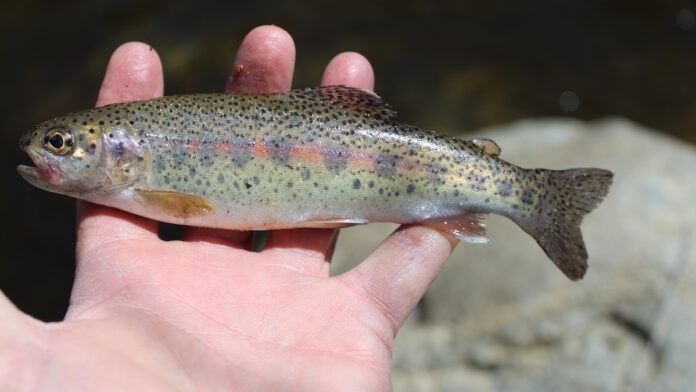Parr markings on a small Kern River rainbow | Jeffrey Walters/Kern Valley Sun
Almost all smaller rainbow trout have “parr markings” along their sides. This is one of nature’s camouflage techniques. When any type of fish has just hatched, they are food for so many other fish, animals, birds and so forth. These black, splotchy markings are just another way to help hide these fish from other predators. They are mainly found in shallower water, and as they quickly grow, they move out into deeper water, losing those parr marks along the way.
However, if you have been fishing the creeks and streams that feed the Kern River, you will likely have already caught some smaller rainbow trout with these markings. Most of these fish are caught in shallow, narrow streams with crystal clear water and deeper pools. These smaller fish fight extremely hard for their size, which is amazingly small, but just how old are they, and did they come from fish swimming and spawning upstream?
The answer to those questions is not so easy to explain, but it is important to understand if you want to catch more fish. The smaller and narrower the stream, the harder it is to catch these wild trout, and even more difficult if this stream or creek has very little overhead cover, such as trees and brush. Becoming the “ninja” and being able to sneak up on these types of water is half the battle. The other half is deciding what fly or lure will work the best because once your offering hits the water, the fish get spooked.
The Kern River rainbow trout is found mainly upstream from Johnsondale Bridge, where the natural water barriers keep the stocked trout from spawning upstream. Most of the creeks and streams feeding the Kern River are the same way; there are natural barriers that limit the stocked trout from spawning upstream. So how do these brightly colored smaller rainbow trout get to those creeks and streams? They have been there for a very long time and simply keep doing what nature tells them to do: Survive, reproduce and keep growing to suit their environment. Local biologists in this region know that just because this little rainbow trout is only 8 inches long, is brightly colored and has huge, dark parr markings on all sides, this fish can be many years old. The marking doesn’t typically fade on wild trout found in these smaller streams; nature keeps them hidden.
The larger rainbow trout found throughout the Kern River lose those protective camouflage markings the older they get, the more water they move around in and hide and the amount of food they consume. The bigger the water, the bigger the food source and the bigger the fish that live there. Stocked trout do not have these parr markings most of the time. Some stocking programs include “fingerlings” as part of the stocking program. Just be careful when you catch these little ones; they are part of a fragile ecosystem.
Credit: Source link































